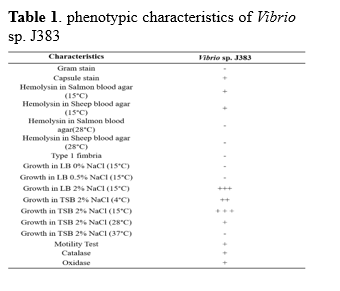COMPARATIVE GENOMIC OF A NEW PATHOGENIC STRAIN ISOLATED FROM WINTER ULCER DISEASE IN ATLANTIC SALMON Salmo salar IN NEWFOUNDLAND
Winter ulcer disease (WUD) is a recalcitrant issue in the salmon farming industry, usually caused by Moritella viscosa . The salmon farming industry has faced detrimental impacts from this disease. The mortality rate caused by WUD is around 10 % during an outbreak.
Fish mostly survive with WUD, but as a consequence of large skin ulcers , and low quality of the filet , significant economic losses can be seen in the industry . Although different types of polyvalent vaccines are used against this pathogen, WUD outbreaks are continuously reported in Atlantic Canada. Currently, it is unknown whether undescribed bacterial pathogens are also causing WUD in vaccinated farmed Atlantic salmon ( Salmo salar ), or the effectiveness of current vaccines is not sufficient. In this study, we described the phenotype and genomic characteristics of a new pathogen ( Vibrio sp J383) isolated from internal organs of Atlantic salmon displaying clinical signs of WUD.
Infection assays conducted in vaccinated Atlantic salmon revealed that Vibrio sp J383 can cause low mortalities when is intraperitoneally administered in high concentration (107 - 108 CFU/dose). Vibrio sp J383 persisted in the blood of infected fish at 10 and 12ºC, clinical signs increased at 12ºC, and no mortality and bacteremia were observed at 16ºC. Vibrio
sp J383 genome is composed of two chromosomes with a total genome size of ~5.9 Mb with ~3.6 Mb and ~2.0 Mb in chromosomes one and two, respectively. Phylogenetic and comparative analyses indicated that Vibrio sp J383 is closely related to Vibrio splendidus , with 93% identity. However, phenotypic studies showed significant differences between them. For instance, the optimal growing temperature for most of the Vibrio species is 28°C. In contrast, Vibrio sp J383 does not grow well at 28ºC and displays an optimal growth between 15-18ºC and substantial growth at 4ºC. Also, Vibrio sp J383 displays hemolytic activity and siderophore synthesis at 15ºC. Our finding suggests that Vibrio sp J383 may be adapted to cold temperatures and its distinctive characteristics compared to other Vibrio species suggest a novel species. This study introduced a new strain that causes winter ulcer disease in Atlantic salmon and highlighted the role of unknown pathogenic strains in this disease.
